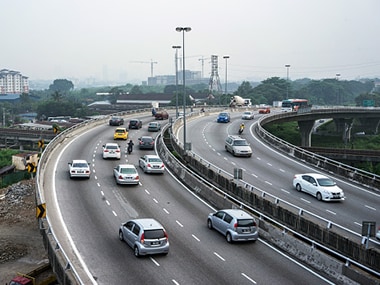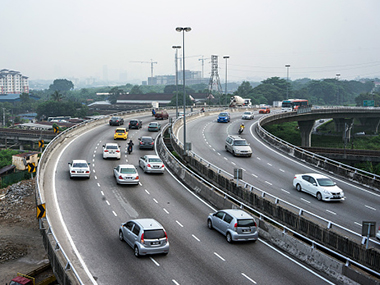One of the major roadblocks of growth for India’s aspiring economy remains the structural bottlenecks in the infrastructure development, something which needs substantial investments and policy support. The findings of a report, released on Tuesday, by rating agency, Crisil, the Indian subsidiary of global rating agency, Standard and Poor’s, offers the latest evidence on this. [caption id=“attachment_2457518” align=“alignleft” width=“380”]
 Road projects are hit by hurdles. Getty Images[/caption] According to the report, around 7,500 km of highway projects — 5,100 km under construction and 2,400 km operational — awarded mostly between fiscals 2010 and 2012 on a build, operate, transfer, or BOT, basis, are at high risk today. Around 50 percent of the projects under construction are at high risk of not being completed because of significant cost over-runs and weak wherewithal of sponsors. One must see the road sector’s problems in the backdrop of the overall infrastructure woes of the country, which have had a direct impact on the asset quality of the banking sector too. Bank have a substantial exposure to such projects. According to the Reserve Bank of India (RBI) data, Indian banks have an outstanding exposure of Rs 1,70,400 crore to the road sector as of end August 2015 compared with Rs 1,60,300 crore in the year-ago period. This is a sizeable fraction of the total infrastructure exposure of Rs 9,41,100 crore. Any failure in these projects would not augur well for banking sector too. According to Sudip Sural, senior director, under-construction projects require equity and cost-overrun support of around Rs 28,500 crore over the next two years. Of this, about Rs 16,000 crore could be stumped up from internal accrual of sponsors and sale of stake at the special purpose vehicle level. That leaves a significant shortfall of Rs 12,500 crore. As for operational highways, 26 out of the total 80 are in no position to service debt on their own because of lower-than-estimated traffic. These projects, which are mostly toll-based, span about 2,400 km, or 40 percent of total length of operational BOT highways, and have an outstanding debt of Rs 17,100 crore. Operational highway projects have been facing cash-flow mismatches in the past few years because of lower-than-estimated traffic volume, and interest rates that were on the ascend until 2014. Now, with interest rates on the decline, pressure will ease a touch but debt service coverage ratios will remain less than 1 over the next two years. According to Sushmita Majumdar, director, CRISIL, the projects require a toll revenue growth of 40% in order to service their debt obligations over the next 2 years. “That’s a tough ask considering that toll rates are linked to WPI inflation, which is in negative territory,” she said. Timely support from sponsors to bridge cash-flow mismatches will be critical because debt in these projects is without recourse to the sponsor, Crisil said. India’s infra story has long been suffering from land acquisition issues and absence of long-term investors. The bigger shock is in the offing for banks in the form of those loans, which have been pushed to the restructuring category in the recent years by bankers to prevent them slipping into non-performing assets (NPAs). If such projects fail to recover, banks will see another round of bad loans for this segment. The practice of masquerading bad loans came to an end when the RBI withdrew regulatory forbearance on recasts and asked bankers to treat restructured loans at par with NPAs, when it comes to provisioning burden (at least 15 percent for a new restructured loan). But the damage is already done for banks since delays in project implementation resulted in higher cost for these projects and impacted their cash flows, hurting the ability to repay to banks. Crisil, however, believes there is a way out of the road sector’s problems with the government announcing a raft of policy measures to help both highway projects and their developers. Of these, the removal of restriction on exit clause alone can allow developers to sell stakes in some projects and raise about Rs 5,000 crore, the agency says. These funds can, in turn, be used to turn around stressed projects, meet existing commitments and also as growth capital. A change of promoter in projects sold could also open up access to better refinancing terms and further financial support. Similarly, developers with operational projects can also securitise receivables to either raise additional debt to support fund commitments or to improve project viability by realigning debt repayment and reducing cost of borrowing. Around Rs 15,000 crore of debt can be refinanced through capital market including through Infrastructure Debt Funds, or IDFs. But the fact remains that the sector desperately needs investments and at this stage, the ability of the banking sector to fund these projects in a big way is limited. As Crisil points out, “timely support from sponsors to bridge cash-flow mismatches will be critical because debt in these projects is without recourse to the sponsor.” The basic point is this: the primary push must come in the form of increased public spending by the government in infrastructure projects, which will, be followed up by private investors in due course.
Road projects are hit by hurdles. Getty Images[/caption] According to the report, around 7,500 km of highway projects — 5,100 km under construction and 2,400 km operational — awarded mostly between fiscals 2010 and 2012 on a build, operate, transfer, or BOT, basis, are at high risk today. Around 50 percent of the projects under construction are at high risk of not being completed because of significant cost over-runs and weak wherewithal of sponsors. One must see the road sector’s problems in the backdrop of the overall infrastructure woes of the country, which have had a direct impact on the asset quality of the banking sector too. Bank have a substantial exposure to such projects. According to the Reserve Bank of India (RBI) data, Indian banks have an outstanding exposure of Rs 1,70,400 crore to the road sector as of end August 2015 compared with Rs 1,60,300 crore in the year-ago period. This is a sizeable fraction of the total infrastructure exposure of Rs 9,41,100 crore. Any failure in these projects would not augur well for banking sector too. According to Sudip Sural, senior director, under-construction projects require equity and cost-overrun support of around Rs 28,500 crore over the next two years. Of this, about Rs 16,000 crore could be stumped up from internal accrual of sponsors and sale of stake at the special purpose vehicle level. That leaves a significant shortfall of Rs 12,500 crore. As for operational highways, 26 out of the total 80 are in no position to service debt on their own because of lower-than-estimated traffic. These projects, which are mostly toll-based, span about 2,400 km, or 40 percent of total length of operational BOT highways, and have an outstanding debt of Rs 17,100 crore. Operational highway projects have been facing cash-flow mismatches in the past few years because of lower-than-estimated traffic volume, and interest rates that were on the ascend until 2014. Now, with interest rates on the decline, pressure will ease a touch but debt service coverage ratios will remain less than 1 over the next two years. According to Sushmita Majumdar, director, CRISIL, the projects require a toll revenue growth of 40% in order to service their debt obligations over the next 2 years. “That’s a tough ask considering that toll rates are linked to WPI inflation, which is in negative territory,” she said. Timely support from sponsors to bridge cash-flow mismatches will be critical because debt in these projects is without recourse to the sponsor, Crisil said. India’s infra story has long been suffering from land acquisition issues and absence of long-term investors. The bigger shock is in the offing for banks in the form of those loans, which have been pushed to the restructuring category in the recent years by bankers to prevent them slipping into non-performing assets (NPAs). If such projects fail to recover, banks will see another round of bad loans for this segment. The practice of masquerading bad loans came to an end when the RBI withdrew regulatory forbearance on recasts and asked bankers to treat restructured loans at par with NPAs, when it comes to provisioning burden (at least 15 percent for a new restructured loan). But the damage is already done for banks since delays in project implementation resulted in higher cost for these projects and impacted their cash flows, hurting the ability to repay to banks. Crisil, however, believes there is a way out of the road sector’s problems with the government announcing a raft of policy measures to help both highway projects and their developers. Of these, the removal of restriction on exit clause alone can allow developers to sell stakes in some projects and raise about Rs 5,000 crore, the agency says. These funds can, in turn, be used to turn around stressed projects, meet existing commitments and also as growth capital. A change of promoter in projects sold could also open up access to better refinancing terms and further financial support. Similarly, developers with operational projects can also securitise receivables to either raise additional debt to support fund commitments or to improve project viability by realigning debt repayment and reducing cost of borrowing. Around Rs 15,000 crore of debt can be refinanced through capital market including through Infrastructure Debt Funds, or IDFs. But the fact remains that the sector desperately needs investments and at this stage, the ability of the banking sector to fund these projects in a big way is limited. As Crisil points out, “timely support from sponsors to bridge cash-flow mismatches will be critical because debt in these projects is without recourse to the sponsor.” The basic point is this: the primary push must come in the form of increased public spending by the government in infrastructure projects, which will, be followed up by private investors in due course.
Economic revival: With 7,500 km road projects turning risky, govt's task just got tougher
Dinesh Unnikrishnan
• October 7, 2015, 09:54:54 IST
The fact remains that the sector desperately needs investments and at this stage, the ability of the banking sector to fund these projects in a big way is limited.
Advertisement
)
End of Article